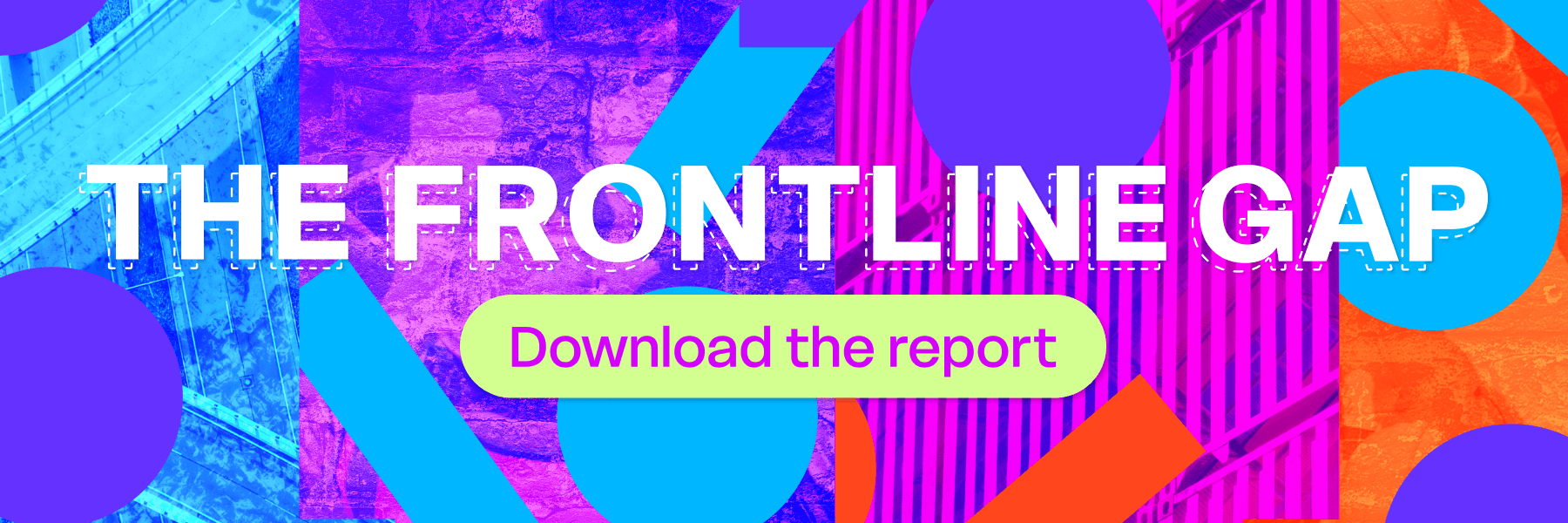Learn from 5,000+ comms leaders on exec buy-in, engagement, and the ROI puzzle.
Frontline Summit Recap: 6 Takeaways on Empowering the Deskless Workforce

Lisa Ardill
Content Editor at Workvivo
June 4 2025

Our first-ever Frontline Summit was an absolute blast – in our totally unbiased opinion!
With innovators, practitioners, thought leaders and expert voices in attendance, there were 9,000 people who came together to talk about one of the most pressing issues for today’s workforce: supporting, empowering and engaging frontline employees.
Across product unveilings, expert panels, and deep-dive research presentations, one message rang loud and clear: it’s time to redesign the frontline worker experience around what these teams really need.
There was a ton to take in, so here's a look at the event's major highlights. Whether you were able to attend our Frontline Summit or not, this look-back is definitely worth a read.
Key takeaways from the Frontline Summit
1. Workvivo CEO: Prioritizing the forgotten frontline
Our CEO John Goulding opened the Summit with a whistle-stop tour of Workvivo’s dedication to frontline employees. He described frontline engagement as an incredibly important topic, but one that doesn’t get enough attention.
We're investing incredibly strongly in Workvivo for Frontline and have an amazing roadmap for the year ahead
– John Goulding, Workvivo CEO and Founder
“With over 80% of the workforce in frontline roles, their experience is often forgotten when talking about the future of work,” John said. “When we talk about frontline, we mean anyone who doesn’t work in an office. These are people we interact with every day – assisting us in stores, boarding us on airplanes, and treating us in hospital.
“When we founded Workvivo, we designed it to inform, engage and connect every employee. What we’ve found is that frontline workers actually get the most value from the Workvivo platform. It’s been amazing for us to see the impact it has on millions of frontline workers, from Delta and Verizon to Kmart and Bupa.
“Our customers call us the digital heart of their workplace, and we’re really proud to be that for thousands of organizations globally.
“We're so excited to be doubling down on our frontline offering to make the experience even better. Workvivo for Frontline includes a recently launched best-in-class chat solution to empower instant, real-time communication. We're investing incredibly strongly in Workvivo for Frontline and have an amazing roadmap for the year ahead that includes video and voice-calling powered by Zoom, task and shift management, and an AI-powered knowledge base – all with an incredibly strong and mobile-first user interface.
“We are so excited for the future of frontline, and the opportunity to connect millions of frontline workers, giving them an incredible employee experience.”
2. The deskless worker experience
Following John’s opening words, global industry analyst Josh Bersin took us on a deep dive into the extensive research he’s done on the experiences of deskless workers.
He presented a six-part framework for understanding and improving frontline experience:
1. Meaningful Work – Employees want to feel purpose and autonomy in what they do.
2. Effective Management – Relationships with supervisors directly impact morale and performance.
3. Supportive Workplace – Flexibility, recognition, and inclusion are crucial.
4. Health & Well-being – Physical and psychological safety must be prioritized.
5. Growth Opportunities – Even task-based roles should offer skill-building and career paths.
6. Organizational Trust – Transparent, ethical leadership fosters loyalty and engagement.
He also emphasized that tools like Workvivo can play a major role in enabling these pillars – by removing bureaucracy, simplifying information access, and creating consistent, scalable communication.
Josh closed with a reminder: so much of the workforce is frontline, and their experience is directly tied to customer satisfaction, brand trust, and business growth. Investing in their tools, voices, and well-being is not optional – it’s essential.

3. Workvivo for Frontline: Evolutions in our product
On the back of Josh Bersin’s segment, Workvivo’s Head of Strategic Customers, Jen Jordan, and our Lead Product Manager, Joe Darrer, discussed our product roadmap.
They unveiled exciting enhancements tailored specifically for frontline workers. Features like live-streaming, voice calling, Workvivo TV, and advanced employee insights with AI-driven sentiment analysis were emphasized as ways to “meet employees where they are” – on the move, between shifts, and often without traditional access to emails or desktops.
Joe outlined five key pillars for frontline functionality: real-time communication, engagement, workflows, tasks, and onboarding. These needs shaped the mobile-first, personalized platform that can adapt to roles across sectors – whether you’re on a construction site, in a hospital, or at a retail checkout.
One standout evolution? AI-powered knowledge search and assistance, designed to help frontline workers quickly find the information they need to do their jobs confidently. Joe likened the impact of AI on frontline experience to the seismic shift of mobile technology, predicting it will become the digital assistant in every worker’s pocket.
4. Real frontline stories from the field
Eddie MacSweeney, our Communications and Engagement Consultant who previously worked in the Irish Defence Forces, has lots of experience leading frontline teams.
Eddie led a Q&A session with representatives from some of our global customers – Salam Al Jishi from Nesma & Partners, David Cutler from Verizon, and Niall Norbury from Royal Berkshire NHS.
He asked Salam about the intricacies of moving information from more strategic levels of the company to the people on the ground – across language barriers, digital divides and on-site labor. She told him that the answer was employing a mobile-based platform.

For David, one of the biggest challenges at Verizon is communicating at scale. David and his team are tasked with disseminating a large volume of information, with speed and accuracy, across thousands of US stores. He told Eddie that infrastructure was crucial in isolating groups, tailoring messages, eliminating irrelevant noise, and moving fast.
Niall shared that at Royal Berkshire NHS – and healthcare institutions in general – leadership visibility is key to staff morale. With Workvivo specifically, he explained that leadership comms no longer need to be anonymous. Positive announcements from the Chief Medical Officer can be attributed to that individual, for example, which builds trust across the organization.
5. The new playbook for frontline comms
Joanna Parsons, CEO of The Curious Route, hosted a panel discussion with some of the most influential voices in internal communication and employee experience.
The panel delivered a reality check on the state of frontline communications – with honest insights, practical advice, and a much-needed focus on humanity over hierarchy.
Stephanie Roberts (Chief Comms Officer at Hitachi) stressed that the real challenge is access – most frontline employees still don't have email or company devices, and companies are clinging to outdated methods like posters and printed memos. The real solution lies in pairing modern tools with a clear strategy and cultural shift.
Kit Campoy, former retail leader and author (The Voice of the Frontline), shared firsthand stories of communication overload on the frontlines. She advocated for streamlining channels: “Two would be a dream.” Her call to action was simple – get out of HQ and observe the frontline flow to design better experiences.
Chris Lee (VP at Gallagher Communication) pushed the panel further by challenging the term “employee-centric”. Instead, he suggested the need for human-centric communications that respect how people live and work. He emphasized content that resonates, such as transforming benefit reminders into accessible, human-language guides.

The panelists agreed that line managers are key conduits, yet they’re too often underprepared. Stephanie recommended short, clear briefing docs and dedicated weekly time (like huddles or toolbox talks) as better ways to support cascaded communication.
Above all, the panel highlighted one enduring truth: frontline workers are time-poor, overloaded, and under-informed.
The future of internal comms is not more – it's less but better: shorter content, fewer channels, more relevance.
6. Engaging 60,000 frontline workers at Bupa
Finally, the event ended with a brilliant and authentic conversation between Katie Macaulay and Jo Hudson.
Katie is Managing Director at AB Comms where she also hosts the Internal Comms Podcast. For the Frontline Summit, she sat down with Jo, Group Director of Internal Communications at Bupa, for a special live episode.
They covered everything from common frontline communication challenges and content strategies to implementing Workvivo and getting leaders involved.

Jo shared that with 60,000 frontline workers at Bupa, a large proportion of the company has no digital access or company email address. Before implementing Workvivo four years ago, they relied heavily on manager cascade communications – a particularly tough thing to navigate in a healthcare environment, where customer data protection and prioritizing patient care are key.
With Workvivo, Jo and her team could reach frontline colleagues with consistent messaging and a unified vision. It allowed them to focus on creating brief, concise content for a time-poor audience, and to emphasize fun and engaging content.
“When we set out on our Workvivo journey, we were just about to launch our new corporate global strategy to everyone at Bupa, which was a very important time,” Jo said. “We wanted everyone to galvanize behind a global corporate strategy and all pull in the same direction and be aiming for the same targets and the same vision. I think Workvivo has been an incredibly important tool for us to help us get that message out. I don't think we would've been able to do what we've done in terms of engaging 100,000 people around the world in that strategy if we hadn't had a tool like that.”
Making frontline engagement more than just an afterthought
When it comes to company culture, frontline workers deserve to be prioritized rather than treated as afterthoughts.
The conversations we had at the Frontline Summit are testament to the power of leading by example, investing in the right technology, and meeting workers where they are - all of which are key steps on the road to truly great employee experiences that don't leave anyone behind.
Our event was just the beginning. Frontline engagement is well overdue a fresh perspective, and we're excited to play our part.
